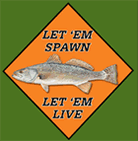Spotted Seatrout Winter Fish Kills
Spotted seatrout are a recreationally-important finfish found in estuaries throughout South Carolina. Spotted seatrout populations are occasionally subjected to mass mortality events when severe winter conditions lead to drastic drops in water temperature, like those observed in the winters of 2000-2001, 2009-2010, and 2010-2011. Spotted seatrout rarely move out of their natal estuaries and spend most of their lives in shallow estuarine flats. Under normal winter conditions, they can adjust to steadily declining temperatures by moving from the shallows into deeper channels in the estuaries and remaining there until temperatures increase again. However, seatrout are especially vulnerable to winter kills when abrupt decreases in air temperature cause their shallow water habitats to chill rapidly and they are unable to escape to warmer, deeper waters.
SCDNR has conducted a long-term trammel net survey within state waters to measure the abundance of spotted seatrout and other estuarine species since 1991. Increases or decreases in population abundance are determined by evaluating trends in catch-per-unit-effort (CPUE), or the number of fish caught per net set. Following the winter of 2000-2001, when temperatures in Charleston Harbor dropped as low as 42˚ F, the survey detected a 93% decrease in spotted seatrout abundance. Similar decreases occurred in the winters of 1993-1994, 2009-2010, and 2010-2011, when minimum temperatures decreased to between 43˚-45˚ F (fig. 1).
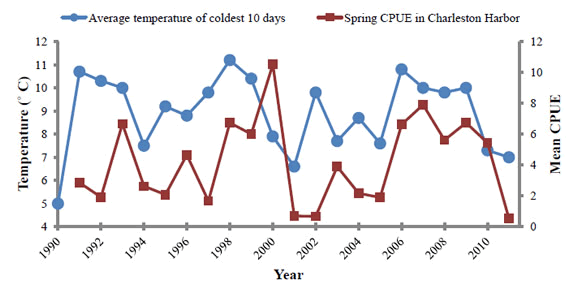
While populations can recover from winter kills after several years, recovery may be aided by management actions such as emergency closures or voluntary catch and release programs that allow the remaining adults the opportunity to spawn in the following season. However, temporary closures and other management actions should be based on a thorough understanding of the magnitude of winter mortality.
To further understand the relationship between decreasing water temperatures and spotted seatrout mortality, we conducted a series of experiments using hatchery fish produced at the Waddell Mariculture Center. The fish were held in 20 gallon aquariums in environmentally-controlled research chambers and subjected to temperatures trials designed to test the limits of their coldwater tolerance (figs. 2 and 3).

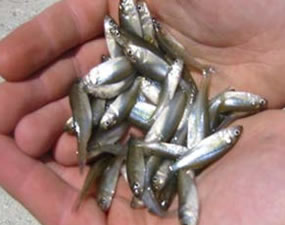
The first experiment exposed fish to a constant dropping temperature that simulated a very cold winter similar to 1994, 2000, 2009, and 2010. The goal of this experiment was to determine the absolute lowest temperature seatrout could withstand. We determined that spotted seatrout first lost equilibrium (turned belly-up) at 39˚ F, but were able to recover. When the water temperature reached approximately 36˚ F, mortality was 100% (fig. 4).
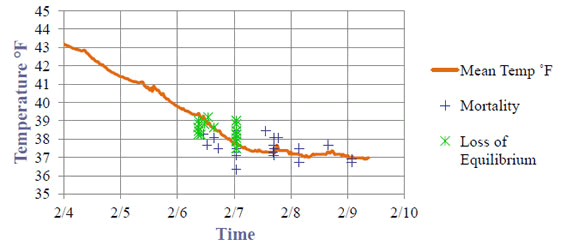
Although these findings provide us with a better understanding of how seatrout populations respond to lethal temperatures, we are currently evaluating the impact that fluctuating sub-lethal temperatures might have on wild populations. The temperature regimes reported above are based on measurements taken in the large, deep and relatively stable Charleston Harbor. Water temperatures fluctuate widely in tidal creeks and can be much lower where juvenile spotted seatrout may be found. Temperature decreases of 1˚ F/hour occurring for approximately six hours are regularly seen in tidal creek environments due to tidal fluctuations.
In our latest experiments, the temperature regimes used were modeled after the creek environment, where the temperature fluctuates several degrees per day with the tidal cycle (Fig. 5). When spotted seatrout were exposed to a stable temperature of 41.5˚ F for 5 days, a small percentage lost equilibrium (4%), but none died. However, when spotted seatrout were exposed to temperatures that fluctuated between 39˚ and 43.5˚ F, 13% lost equilibrium and 4% died.
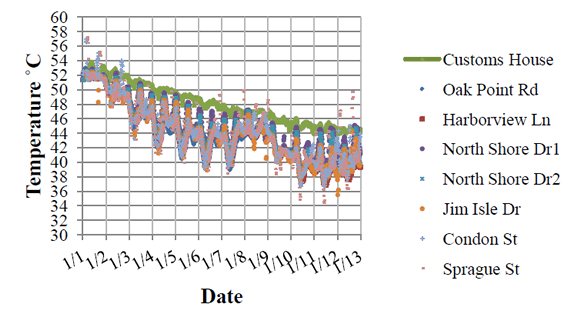
Future experiments will test the low-temperature tolerance of different sized seatrout as well as the health of the fish going into winter. We anticipate that the data collected from these experiments will be used to model the impacts that different winter temperature scenarios will have on spotted seatrout mortality. Real-time knowledge of winter kills would allow fishery managers to educate the public about voluntary catch and release programs in a timely manner or implement a fishery closure in the most extreme circumstances.



